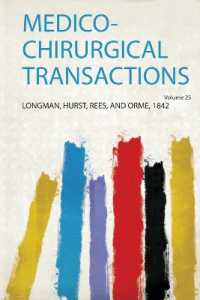- ホーム
- > 洋書
- > 英文書
- > History / World
Full Description
The history of dining is a story that cannot be told without archaeology. Surviving texts describe the opulent banquets of Rome's wealthy elite but give little attention to the simpler, more intimate social gatherings of domestic invitation dinners. The lower classes, in particular, are largely ignored by literary sources. We can, however, find the voices of the underprivileged by turning to the material detritus of ancient cultures that reflects their social history. Dining at the End of Antiquity brings together the material culture and literary traditions of Romans at the table to reimagine dining culture as an integral part of Roman social order. Through a careful analysis of the tools and equipment of dining, Nicholas Hudson uncovers significant changes to the way different classes came together to share food and wine between the fourth and sixth centuries. Reconstructing the practices of Roman dining culture, Hudson explores the depths of new social distances between the powerful and the dependent at the end of antiquity.
Contents
Contents
List of Illustrations
Acknowledgments
Introduction: Roman Tables
1. "We Should Invite Friends": The Written Evidence
2. " Bring the Couch Red with Fine Linen": The Physical Elements of Atmosphere
3. "Lordly Dishes": Table Equipment
4. " Gleaming Paneled Vaults": Architecture, Furniture, and Lighting
5. Images of Communion
6. "For the Sake of Eating": Patrons at the Table
7. "For the Sake of Living": Clients at the Table
8. " None Should Suffer Wrong": Social Justice and Division at the End of Antiquity
Bibliography
Index








